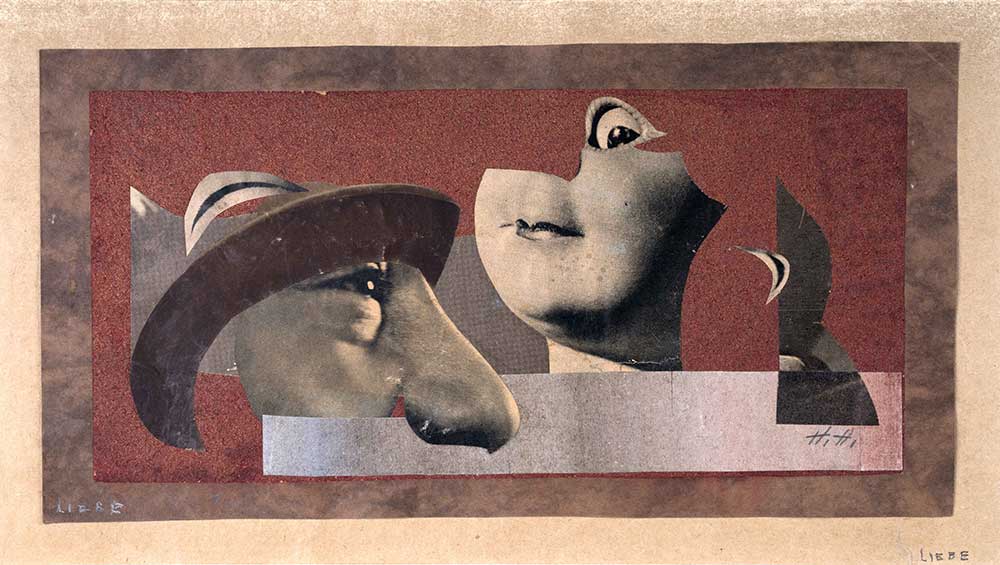
Hannah Höch, Love, 1926. This work is part of the ifa art collection. Photo: © Christian Vagt; © Bildrecht, Vienna 2024.
Lower Belvedere, Vienna, Austria
21 June – 6 October 2024
by CHRISTIANA SPENS
The German artist Hannah Höch (1889-1978) was one of the pioneers of photomontage, the practice of cutting and pasting together photographs and printed materials from newspapers, fashion magazines and other sources, to create a striking new image. First alongside the Berlin dadaists and then, after the second world war, in isolation, Höch probed the power and impact of images with her comic but critical gaze. More than 80 of these photomontages are now on view in a retrospective at the Belvedere, the first in Austria to be dedicated to the artist.
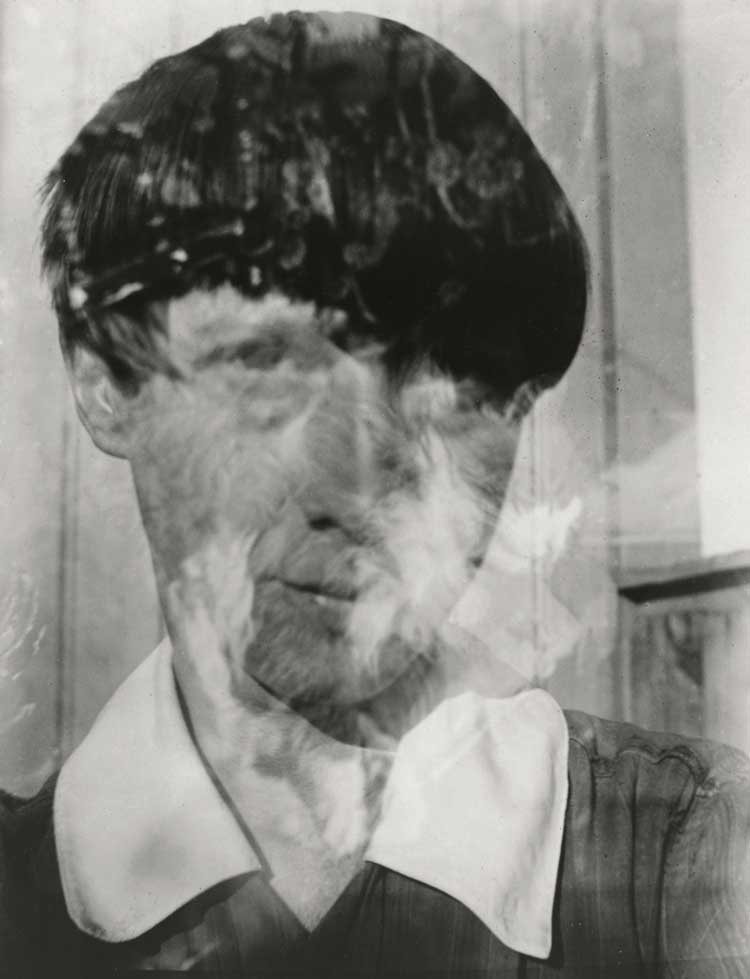
Double exposure photograph of Hannah Höch, undated, photographer unknown. Berlinische Galerie – Landesmuseum für Moderne Kunst, Fotografie und Architektur, Repro: Anja Elisabeth Witte / Berlinische Galerie, © Bildrecht, Vienna 2024.
After graduating from art school, Höch took a job with the German magazine publisher Ullstein, which gave her access to a vast supply of new visual material, which she then used to create photomontages, juxtaposing fashion images with political figures to create provocative and clever visual statements about current affairs. In Heads of State (1918-1920), for instance, she used cut-outs from a newspaper of German president Friedrich Ebert and defence minister Gustav Noske in their bathing trunks and placed them on top of an embroidery pattern showing a woman with a parasol and decorated with flowers and butterflies, in a mockery of the Weimar Republic leaders. In The Father (1920), she questioned modern masculine ideals, and how they could be jarring, when she combined a man’s head with the body of a woman wearing high-heeled shoes and cradling a baby. To the right of this figure, there is a muscular boxer who aims a punch at the child, with female athletes dancing around. Though her images were often lighthearted and playful at first glance, a closer inspection revealed harsh criticisms and deconstructions of the social norms around her, in carefully composed scenes of chaos.
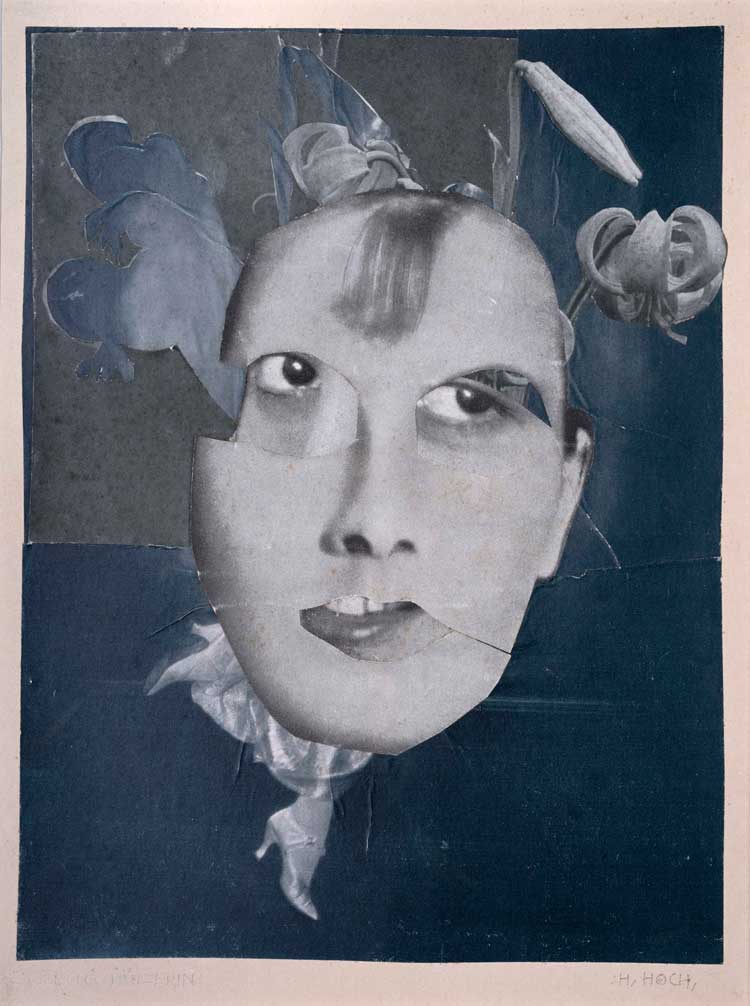
Hannah Höch, English Dancer, 1928. This work is part of the ifa art collection. Photo: © Christian Vagt; © Bildrecht, Vienna 2024.
The exhibition also presents a selection of her lesser-known drawings, paintings and prints, as well as projections of films by her contemporaries, including Hans Richter, Dziga Vertov and Fernand Léger, revealing the parallels between their work on screen and hers. In Richter’s Inflation (1928), for instance, he addressed the hyperinflation crisis of 1923, which, the wall text tells us, led to devaluation of the currency and a billionfold increase in prices In fragmented and superimposed imagery, Richter revealed a society in ruins as a small minority rose to riches; it was against this political and economic catastrophe, as well as the trauma of the first world war, that the dadaist movement arose, mirroring the sense of brokenness that was all around them. Höch and her peers evoked the injured, depicting maimed bodies and artificial limbs in their photomontages to reveal the brutality of war, and how it was inescapable throughout German society of the 1920s. Photomontage expressed the dadaist desire for a radical new beginning in art, based on the idea of disassembling the world into its component parts in order to construct a new, better one. As the dadaists created provocative artworks, communism and fascism gained popularity for their parallel reactions to social and economic devastation, and the wounded national identities that went with it.
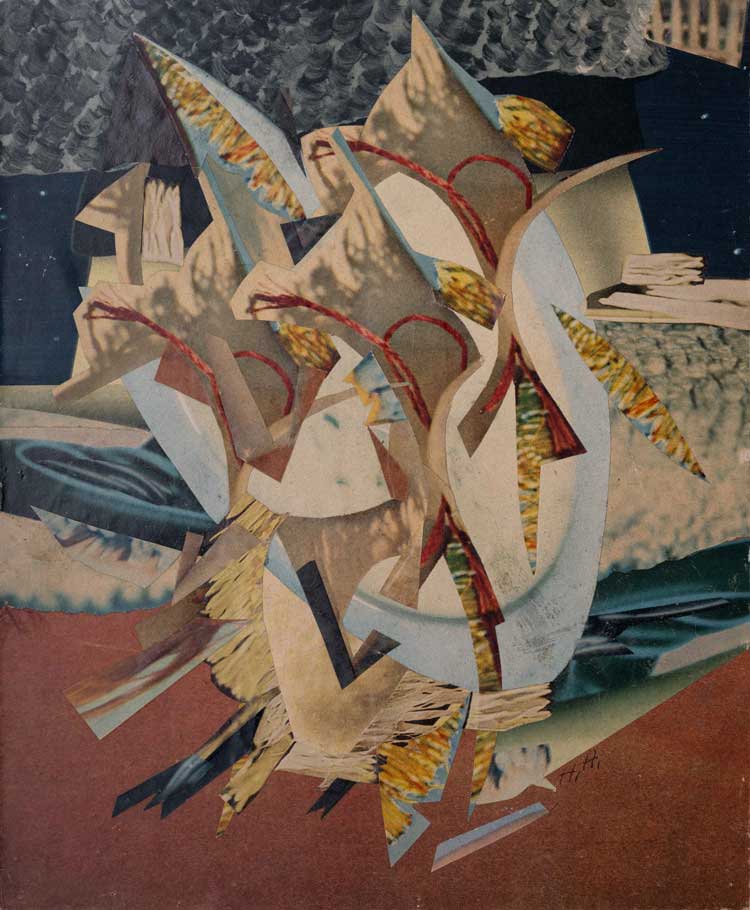
Hannah Höch, Epic (detail), 1957. This work is part of the ifa art collection. Photo: © Christian Vagt; © Bildrecht, Vienna 2024.
Höch was not as politically focused as some of her peers, but much of her work exposed the gender norms that prevailed, and the problems inherent in those structures. Höch was bisexual, and though she is now widely celebrated as a dadaist, as a young artist she didn’t fit comfortably into the dadaist community, who were at times ambivalent towards her even as they shared political and aesthetic ideas. Her critical depictions of modern masculinity perhaps reveal her own ambivalence towards them, too. She was the only female artist of the group and, as such, was often undermined. While her work was championed by Raoul Hausmann, with whom she had an affair that lasted seven years, other members of the group were often hostile. Richter, in Dada: Art and Anti-Art (1965), questioned why Höch was involved with dada at all, describing her as a “quiet girl” among more extroverted, abrasive male peers. Richter described Hausmann as Höch’s “mentor” and writing of Höch’s involvement in the First International Dada Fair of 1920, said: “She only contributed collages.” She was often discouraged from exhibiting and was rarely published in the Berlin dada journals; even her participation in the 1920 fair was organised by Hausmann against the wishes of fellow dadaists George Grosz and John Heartfield.
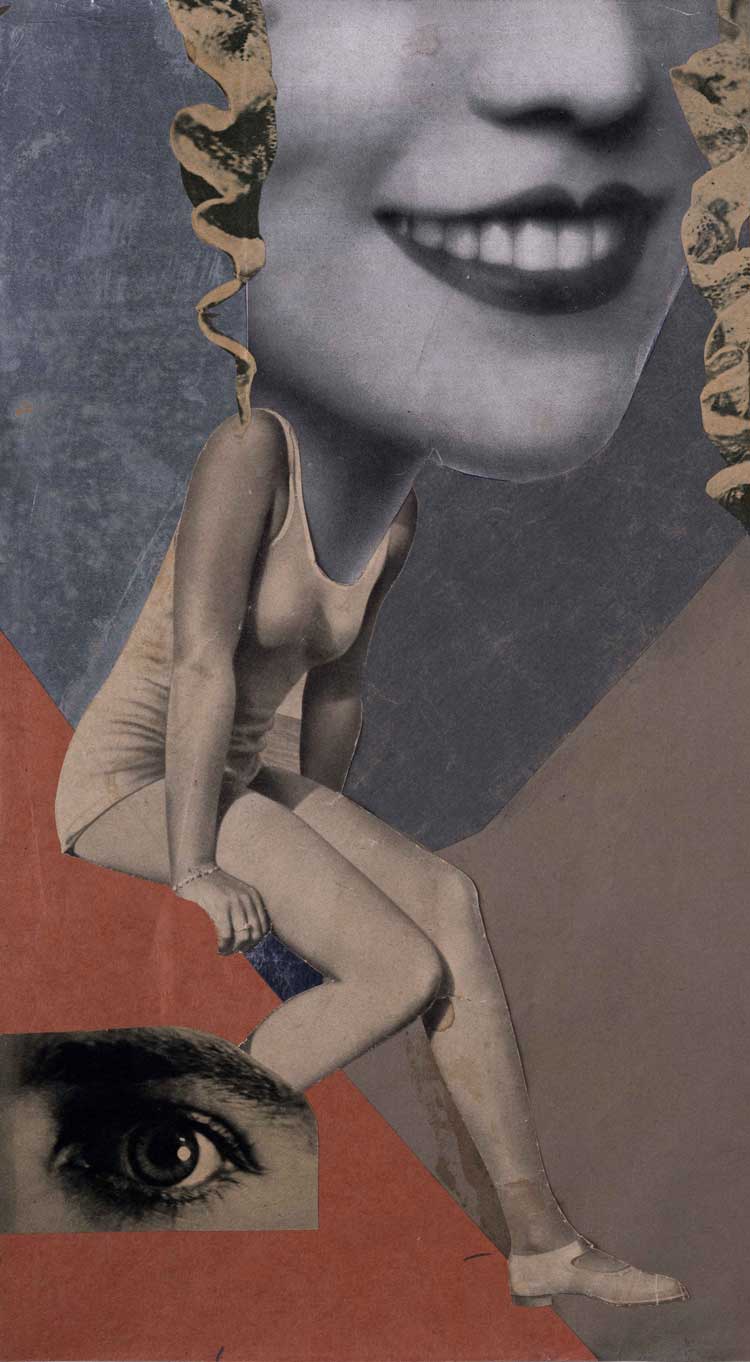
Hannah Höch, Made for a Party (detail), 1936. This work is part of the ifa art collection. Photo: © Christian Vagt; © Bildrecht, Vienna 2024.
Infighting aside, they were all damned by the Nazis in the end. In the 1930s, as fascists rose in power, Höch and her peers were banned as “degenerate artists” and faced persecution. Most left Berlin, although Höch stayed, refusing to support the Nazis but refusing also to leave her home. “I had to disappear as completely as if I lived underground,” she later wrote.1 She lived an isolated, fearful existence thereafter, burying her archive and the art she owned in her garden so that it would not be destroyed or stolen, and cutting contact with other artists so as not to endanger them or herself. She kept working secretly, immersing herself in her imagined world as she lived on the vegetables grown in her garden. As Berlin was bombed, she created a photomontage with the leaping legs of ballerinas and a winged creature that she titled, Never Keep Both Feet on the Ground (1940). She retreated into her own imagination.
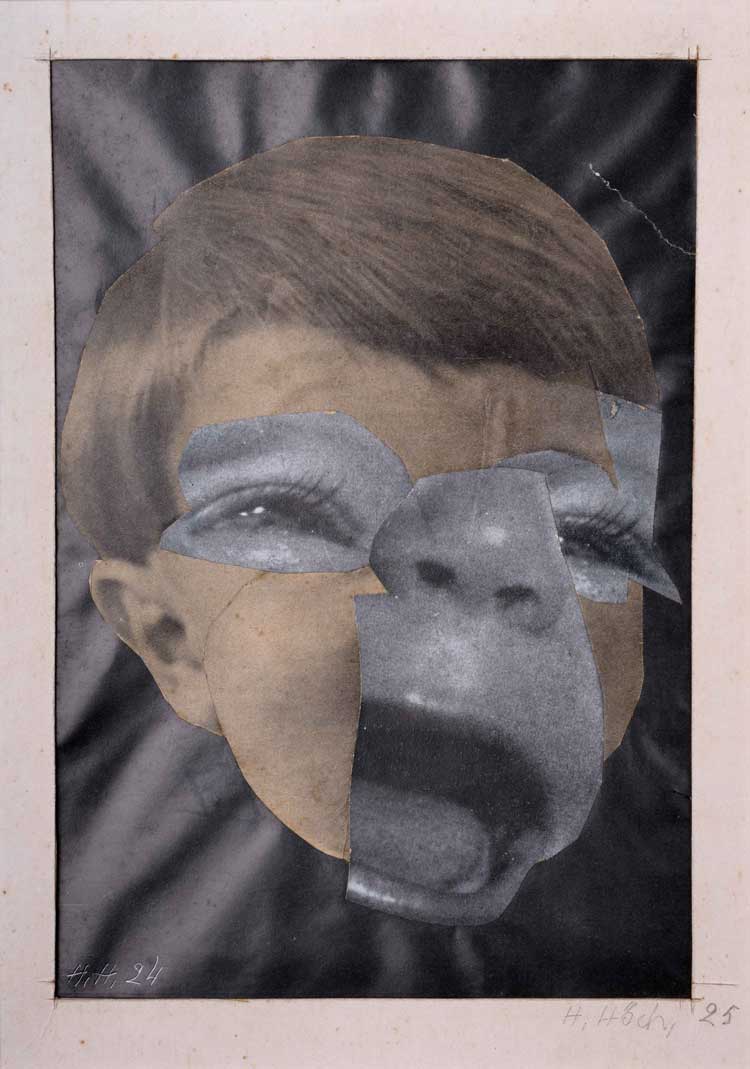
Hannah Höch, Children, 1925. This work is part of the ifa art collection. Photo: © Christian Vagt; © Bildrecht, Vienna 2024.
Even after the war ended, she never again produced political or satirical work, and she remained in her own world, turning from a once outward-facing and socially engaged young artist to one focused on nature, imagination, mysticism and animals – and the promise of magical thinking. When reality seems unfathomable or unbearable, as it must have done during those decades, the idea that it may be distorted and escaped through art is a compelling one, and Höch’s later works are clearly a reaction to a world that was impossibly tragic and on which she had basically given up. Höch distanced herself from the dadaists and their political satire and turned towards the fantastical realm of surrealism; her works would not comment on the world around her so much as create a new one divorced from the reality of Berlin in the 1920s, 30s and 40s.
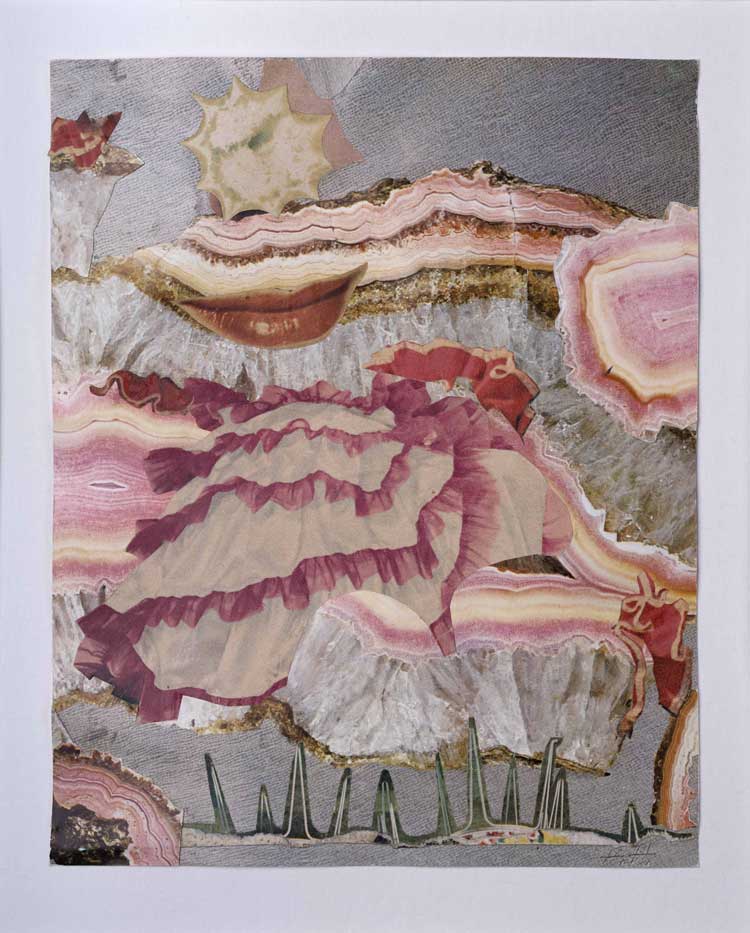
Hannah Höch, Around a Red Mouth, 1967. This work is part of the ifa art collection. Photo: © Christian Vagt; © Bildrecht, Vienna 2024.
Instead, Höch created entrancing, surrealist works such as The Red Head (1964) and Around a Red Mouth (1967), with a bright and yet tender sensuality, combining images of soft fabrics alongside glittering rocks, which together create a bewitching psychedelia. This escapist outlook was radical and optimistic in its way. As she said in 1949: “I am a human being; I can, however, by virtue of my fantasies, be a bridge. I wish to convey that what seems impossible is possible. I want to help people experience a much richer world, so that we can engage more benevolently with the world we know.”2
Höch found in her intentional departure from reality a means of connection and empathy with other people, as if bonding through the shared desire to divorce oneself from the world and its brutality.
In her last work, Life Portrait, which was also one of her largest, she assembled a collage using photographs of herself and her work, as well as important people in her life, including her former lovers Hausmann and Mathilda Brugman. There are also images from her prized garden everywhere, seemingly holding her life together. What is striking is that it includes very few of the Dada artists she is now associated with and who inspired her work in the beginning, or her work from that period. But perhaps this should not be that surprising; there was such dissonance in Höch’s earlier work and in the cultural movement that inspired so much of it, responding to an era characterised by conflict, widespread trauma and powerlessness. When she came to assemble a portrait of her life, Höch chose to edit out those parts.
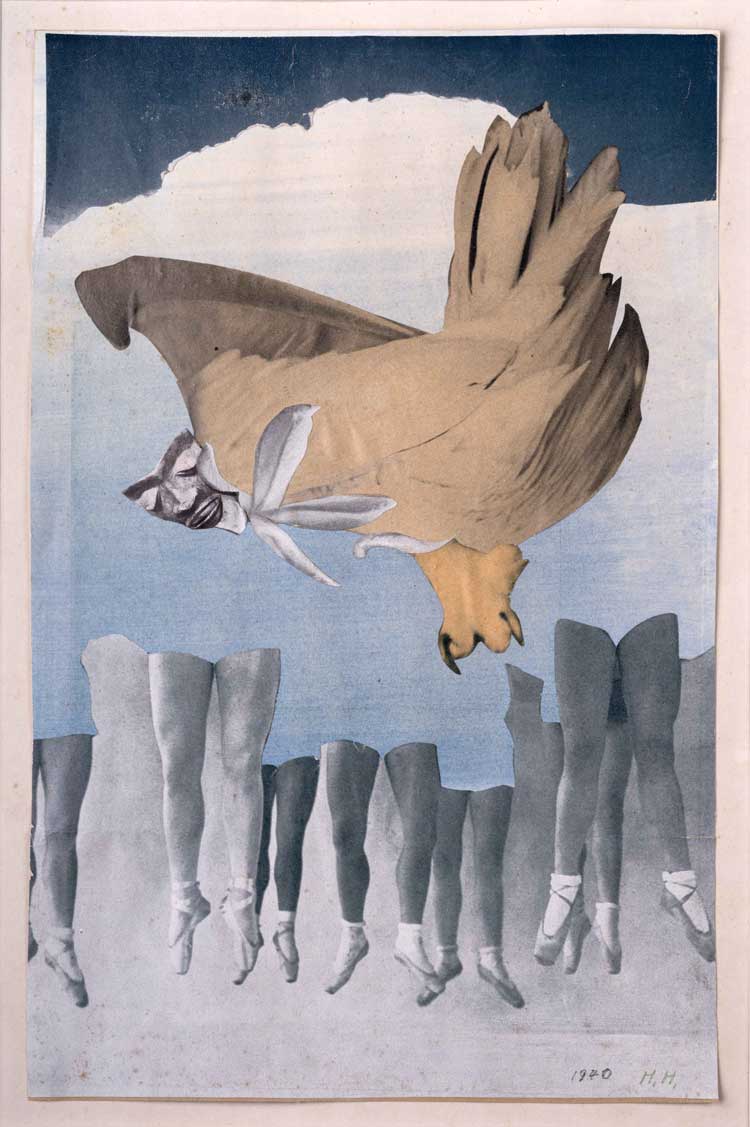
Hannah Höch, Never Keep Both Feet on the Ground, 1940. This work is part of the ifa art collection. Photo: © Christian Vagt; © Bildrecht, Vienna 2024.
What emerges from this artistic practice is Höch’s persistent will to create work despite the chaos, tragedy and disillusionment in the world around her, and indeed as an antidote to it. The dadaist dream was that in critiquing and reassembling the world around them, they could create a better society; Höch ultimately gave up on this happening in any world other than the magical, fantastical one of our imaginations. In the end, after the horror and isolation of fascism and war, only the escapism and beauty of art and her own garden persisted. Höch chose to reassemble her memories in a way that could momentarily erase the brutality she had seen and wished to be free of, connecting to people through visions of beauty and sensuality instead.
The retrospective as a whole, however, shows a fuller picture of Höch’s life and work, enabling us to see the different worlds she lived through, and also how one horrific era would affect people in such various ways. I left Assembled Worlds thinking about how we all create montages of memories for ourselves – some engaging with the world, some separating from it, some sarcastic, others joyful – but all constructing some new vision of life out of scraps and treasured things alike. Höch may have embraced emotional repression in her later years, and yet in this magical thinking, and in her life-long desire to distort reality, she reveals something haunting and moving about the inventive ways we all sustain our lives, no matter the brutality around us.
References
1. Quoted in Hannah Höch by Charlie Fox, Frieze, 18 March 2014.
2. Translated in Hannah Höch: Museo Nacional Centro de Arte Reina Sofía (Höch in Aliaga, 2004b, page 311). With the note: “Text produced from the catalogue of the show Hannah Höch, Galerie Franz, Berlin, 1949. Quoted by Götz Adriani in Biografische Dokumentation in Hannah Höch. Collagen, Institute für Auslandsbezeihungen, 1984, page 52.”